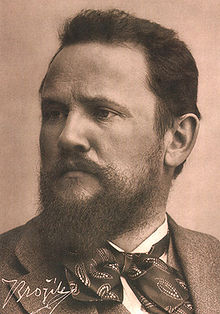|
Václav Brožík
 Václav Brožík (pronounced [vɑ:tslaf br̩oʒiːk]; 6 March 1851, Třemošná – 15 April 1901 Paris) was a Czech painter who worked in the academic style. LifeHe came from a poor family, studying lithography and porcelain painting through apprenticeships. Beginning in 1868, with financial assistance from a local landowner, he was able to attend the Academy of Fine Arts in Prague. He made a trip to the Netherlands, where he studied the Old Masters, then settled in Paris (despite not being able to speak French), where a letter of recommendation assured him the support of Jaroslav Čermák. In 1879 he married Hermina Sedelmeyer, daughter of the wealthy Parisian art dealer Charles Sedelmeyer.[1] For most of his life, he divided his time between Paris and Prague, where he became a Professor at the Art Academy in 1893. He was named a member of the Institut de France, partly through the influence of his father-in-law, who also suggested that he do a painting on the theme "Tu Felix Austria Nube" (from an old saying: "Let others wage war: thou, happy Austria, marry").[2] The result pleased Emperor Franz Joseph I, who was involved in an unhappy marriage. As a result, Brožík was elevated to the nobility.[1] He also became a member of the Académie des Beaux-Arts, received the Grand Cross of the Légion d'Honneur[3] and was appointed to the Czech Academy of Arts and Sciences.[4] One of his 1884 paintings, showing Columbus soliciting the aid of Queen Isabella, appeared on a United States postage stamp in 1893.[5] [6] His health began to decline in 1894, but he threw himself into painting even more diligently. He died suddenly of heart failure in 1901 and was buried in Montmartre.[1] Appreciation of his work suffered a serious decline after his death, as it was considered old-fashioned, but a major retrospective in 2003 has created some renewed interest. References
Further reading
External linksWikimedia Commons has media related to Václav Brožík.
|
||||||||||||||||||||||||||
